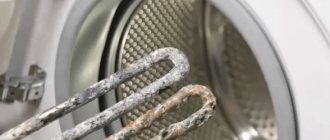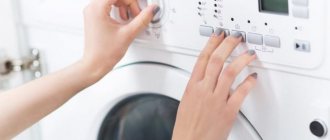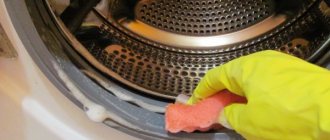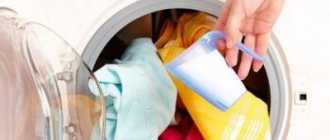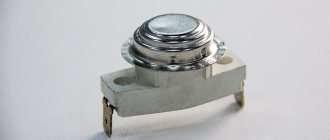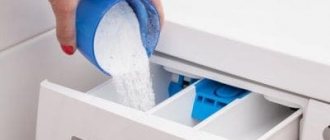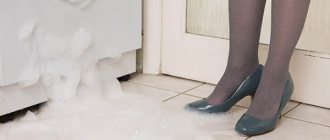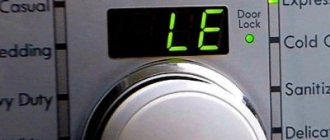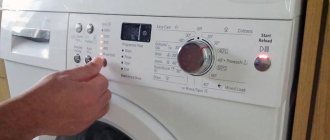Any washing machine needs special care. In addition to taking good care of your equipment, regular cleaning is recommended. Many people use expensive purchased products for this purpose, while others successfully use traditional methods. Cleaning a washing machine with soda is a procedure that can easily be done at home. Many people find it a simple and effective way to get rid of plaque and dirt.
Why soda?
The fact that soda can be used for household purposes comes as a surprise to many, because many housewives are accustomed to buying special cleaning products in chemical stores. In fact, this powder has many possible uses. One of them is cleaning washing machines.
To understand why soda turns out to be an effective means of combating washing machine contamination, you need to understand the issue of their appearance. For some, it remains a mystery how it happens that ordinary things are washed, and such “garbage” appears in the form of plaque, scale and dirt. In addition, an unpleasant odor appears, which is somewhat reminiscent of the smell from the bathrooms.
The answer to the question is simple: the water we use for washing is to blame. Unfortunately, most housewives do not have special filters for cleaning, and they cannot provide absolute purification of the water. In addition, water hardness negatively affects the condition of the metal from which the equipment is made. Therefore, plaque accumulates both on the drum of the washing machine and on the heating element. If you do not start to fight its formation in time, this can lead to breakdown of the machine, and in some cases to its complete malfunction.
Soda tends to have a softening effect. This is useful when the main source of plaque formation is excessive hardness of the water used for washing. In addition, baking soda is chemically alkaline, so it can dissolve harmful acids and other contaminants. Baking soda also has bleaching properties, which improves the condition and appearance of the internal parts of the machine. Thus, soda is a universal remedy that can protect the washing machine from various types of contaminants and extend its service life.
Cleaning mold with baking soda
Mold in a washing machine is quite unpleasant and is considered hazardous to health. But this problem can be solved, since you can clean the machine yourself.
You should prepare a universal cleaning agent that will help remove the fungus: you need to make a paste from soda powder and water. Wipe the machine parts with the resulting mixture using an old toothbrush and leave for 30 minutes. At the end of the specified time, pour up to 400 g of soda into the machine (into the powder tray) and turn it on. The temperature should be set to the highest possible value. After completing the process, you need to wipe the drum with a dry cloth.
How to descale a washing machine with soda
Most often, scale forms on the washing machine filter, which can be easily cleaned with soda. To do this you need to take it out. Modern models provide easy pulling of the filter, so you can do this yourself. Some, out of ignorance, are afraid to do it themselves, so they call a specialist.
So, first you need to drain the existing water. To do this, place a small container, open the bottom cover of the panel, drain the water from the hose and take out the filter. We clean it outside and inside with soda.
There are two ways to do this:
- Prepare a soda solution. To do this, dissolve 2 tablespoons of powder in 0.5 liters of clean water at room temperature and mix. Then we lower the filter into the container with the solution and wipe it with a rag;
- Sprinkle a small amount of powder onto the filter and wash it carefully with a soft cloth. Then we rinse it in clean water.
If all the scale is not removed the first time, you can try cleaning again.
Reviews from experts
Experts advise cleaning the washing machine with soda once a month for preventive purposes. If it doesn’t work out so often, then be sure to do it once every 6 months. Experts emphasize that soda is especially important if the water is hard, since it is this quality that forms scale, which later leads to serious damage .
Advice! When using vinegar solution and soda, it is not recommended to exceed the established dosages of the first component, since in large quantities it negatively affects the rubber elements of the device.
Instructions for use
Let's also consider other options for cleaning a washing machine with soda. First, let's talk about external cleaning. Oddly enough, some housewives simply wipe the top surface of the machine with a damp cloth, thinking that nothing will happen to it. In fact, after a few months, and maybe even years (it all depends on the quality and integrity of the manufacturer), the question arises of how to return the equipment to normal condition.
To clean the outside of the machine you will need baking soda, dishwashing liquid/gel, and a brush (you can use a toothbrush). For 1 liter of water, take 100 ml of detergent and add 100 g of soda. Mix the solution thoroughly and begin washing with a brush. The product can be applied to the walls with a sponge or rag, and a brush can be used to wash the door, rubber seal, and trays. After this, we wipe the entire machine, first with a clean damp cloth, and then with a dry one.
Now let's look at the instructions on how to clean the drum and other internal parts of the machine using soda. For this we need a pack of soda. Pour it into the powder tray, and pour the remaining part that does not fit there into the drum. Then select the fastest washing mode and the maximum permissible temperature. Turn on the wash and wait until the drum is filled with water. Then we wash “idle” and before the water starts draining, we pause. It is best to leave the machine in this condition for 2-3 hours. Then we finish until the end.
Housewives are very surprised how much garbage ends up inside the machine. If the functions allow, you can open the drum while it is standing and see how dirty the water is.
It is best to clean regularly with baking soda. How often this should happen depends on how often you use the machine. Experts recommend cleaning at least once a month.
Causes of odor
- Limescale, or scale, on the internal parts of the washing machine. In the absence of regular cleaning, the resulting plaque can produce a rather noticeable odor.
- Formation of mold and pathogenic bacteria. Typical for machines with horizontal loading. Often, in these types of washing machines, after the next washing cycle, the water is not completely drained, and some of it remains in the gasket of the hatch for loading laundry. Therefore, after finishing work, many people prefer to leave the drum open. Moisture accumulates in a closed drum, and dampness, as you know, is an ideal environment for the proliferation of microorganisms. The natural result, again, is an unpleasant smell of rot and mold.
- You may have washed your laundry at the lowest temperatures and fast rinses. In this mode, dirt, and therefore bacteria, are not completely washed out of clothes, but settle on the walls of the hatch and internal parts. In other words, microbes simply wander from one place to another.
- You used low-quality washing powders or other detergents.
- The drain hose is not connected correctly to the drain. The water does not drain completely, water circulation is disrupted, and odors from the sewer rise to the top.
- Hard water, the sediment and salts of which can cause deposits inside the machine structure.
Soda and vinegar
Vinegar is another handy remedy that is probably in every home. It can also be used to clean the washing machine, perfectly complementing the beneficial properties of soda. It is best to use alcohol-based white vinegar. You can buy it in household chemical stores. If this is not possible, then you can use regular 9% vinegar.
First, prepare the solution. Take 0.5 liters of vinegar, 0.250 g of baking soda and 0.250 ml of water. We also prepare a sponge; it is advisable to take one in which one side is made of a hard material, but it should not be a brush. Mix soda with water. This solution will be poured into the tray into which the powder is usually poured. It is also advisable to clean it first; this is why you will need a sponge. We wipe the tray with a sponge, moisten it in a small amount of soda solution, and pour the solution itself there. Pour the vinegar into the drum.
After this, we start the wash, choosing the mode that takes the longest time. It is also recommended to select the maximum drum rotation speed. After the first cleaning, you will be able to open the machine and notice an excellent result. If necessary, cleaning with soda and vinegar can be repeated several times in a row.
Other washing machine products
In addition to the listed cleaning products, you can do industrial cleaning, which are available in markets and stores: Komet, Pemolux, Calgon, Domestos, Belizna, Utenok and so on. In this case, act according to the instructions on the package.
Important! If the product contains chlorine, it is better not to purchase it. It acts aggressively on any materials.
Proper care of your washing machine will prolong its working condition. It is advisable to clean it once a week. Preventing scale will also avoid replacing the heating element.
Subscribe to TechnoCouncil on social networks so you don’t miss anything:
Soda and citric acid
Citric acid can be used as a stand-alone washing machine cleaner or combined with baking soda. If you use only it, then one procedure will require up to 6 packs of acid. Housewives note that it is the combination of soda with citric acid that brings excellent results.
To do this, you need to take 4 packets of citric acid (they are usually sold in 30 g volumes). You will also need 100 g of soda. Pour both acid and soda into the powder tray, select the longest and fastest washing mode and turn on the machine.
This cleaning method is effective due to the action of acid, which enhances the effect of soda and both substances cleanse the machine of salts and metals that have accumulated due to water hardness. Moreover, with regular use of this method, the scale that formed a long time ago will be gradually removed.
Cleaning with soda from odor
Limestone deposits on parts of the inside of the washing machine create an odor if not cleaned regularly . To get rid of it, you can use soda ash powder. To do this, you will need to take the following actions.
- Wear rubber gloves to prevent an allergic reaction.
- Mix water and baking soda in a 1:1 ratio until smooth.
- Lubricate parts susceptible to mold: powder loading section, drum, cuff folds. Using an old toothbrush and cotton swabs, wipe small parts and hard-to-reach places.
- Leave the solution for 30-40 minutes.
- Use a dry cloth or sponge to rub the stained areas.
- Turn on the machine empty, setting it to the quick wash program.
Cleaning the washing machine with soda ash
High-quality cleaning of the washing machine can be done using soda ash. This substance is more aggressive than ordinary baking soda, so the first rule for its use is the need to work with gloves. If soda ash gets on the skin, it will cause a burn.
To clean your washing machine you need to:
- Make a soda solution. To do this, take 100 g of soda ash and dilute it in 100 g of clean water at room temperature, stir until a homogeneous mixture is formed;
- Apply the mixture to the drum and the rubber layer around it. It is in the folds of this rubber layer that usually contain the largest amount of scale, mold and other contaminants;
- We wait half an hour and remove the mixture along with the dirt using a sponge, while trying to remove all residues;
- We turn on the wash “idle” to make sure that all the soda ash is removed. We select any mode, while turning on the maximum speed.
Cleaning the machine with soda ash
Before the cleansing procedure, rubber gloves are worn to avoid allergic reactions on the skin. To remove plaque, it is recommended to use soda ash after mixing it with water.
The mixture is applied to areas prone to mold. They are the drum, the powder compartment, and the cuff folds. For cleaning, you can use cotton swabs and a toothbrush.
Instructions:
- To prepare the solution, use soda ash or baking soda. It is dissolved in water 1 to 1. The components are mixed until smooth, applied to the drum, and other parts are processed.
- The soda solution is left on the parts for 30 minutes, then the treated areas are wiped with a sponge.
- The quick wash mode is set without items.
- Internal parts are treated for deep cleaning. The heating element is not touched during the procedure. To prevent scale formation, water is softened. The effect is achieved by placing 100 g of sodium bicarbonate in a powder container. Afterwards, a single rinse in fast mode is activated.
- The hose and filters are unscrewed, then removed and washed with a soda solution. First, the inlet hose is removed, then the valve is removed. The area under the tap is washed. All elements are inserted back into the machine and screwed.
- At the end of the procedure, the drain filter is cleaned. It is located at the bottom of the washing machine under the lid. A basin is placed in advance to prevent the formation of a puddle. After removal, the filter is treated with a solution of NaHCO3 and washed under the tap. The nest is cleaned, then the treated element is placed.
It is recommended to repeat the procedure 2 times a month when using soda ash. To maintain cleanliness, a pinch of a chemical element is added to the powder with each rinse.
What is the difference between baking soda and soda ash?
Baking soda is more popular than baking soda. This is explained by the fact that its chemical composition makes this product harmless to humans, so we even use it for oral administration, for example, in baking or drinking the popularly known “fizzy drink” for heartburn.
By their nature, both baking soda and soda ash are alkaline. However, their chemical formulas are different. Baking soda is the weakest alkaline product compared to soda ash or caustic soda. Caustic soda is so powerful that it is used only in the chemical industry; it is dangerous for humans. As for soda ash, it is this that is in greatest demand when used for household cleaning. Its chemical composition is not so weak that it should be added to baked goods, but also not so aggressive that its use should be avoided altogether.
How else can you clean your washing machine?
There are actually many ways to clean your washing machine. When deciding which one to choose, you need to proceed from the availability of a particular product and the condition of the machine. In some cases, when no one has looked after the equipment for years, it is best to contact a specialist who will conduct a technical inspection and assess the general condition.
For those who decide to care for the equipment themselves, the following options are suitable:
- "Calgon" and other purchased products;
- Bleach;
- "Antiscale";
- Whiteness, etc.
In fact, a product that is suitable for one washing machine may not only not help, but also harm another. Therefore, you should always first consult with a specialist or carefully study the features of the model and technical characteristics of your equipment.
Using soda and washing powder
You can add soda at the stage of washing clothes, this will help eliminate the appearance of scale, fungus and odor, especially if the water is of medium hardness. In this case, 2-3 tbsp. spoons of soda powder should be poured into the compartment along with the washing machine; adding directly to the drum is also effective.
Important! If the hardness is very high, it is necessary to increase the number of tablespoons of soda to five. In this way, preventative cleaning of the washing machine will be carried out.
Also, adding baking soda powder when washing is a simple and cheap way to whiten laundry and remove stains from clothes. To do this, you should use soda ash, which is placed in the powder compartment in equal quantities with the powder (as a stain remover) or without it (as a bleach). Then turn on the washing machine, setting it to full mode. When bleaching, after the procedure you need to additionally wash your laundry with powder.
Using soda allows you to:
- remove old greasy stains;
- preserve the structure of the fabric;
- enhance the effect of the powder used;
- eliminate unpleasant odor from laundry.
The use of soda ash is relevant for cotton and linen products. When washing wool, silk, as well as clothes that have a special membrane coating, it is strictly forbidden to use alkali.
Preventing odor and scale in the washing machine
Compliance with preventive measures will allow you to use your washing machine for years and not think about possible breakdowns.
Experts recommend following these measures:
- Purity. Washed laundry should not be stored in a drum, especially a closed one. In such conditions, moist heat is obtained, which fungi, mold and other equipment pests “love” very much. You need to make it a rule to take things out of the drum immediately after finishing washing;
- Ventilation. Wet streaks that form on the walls are another ideal condition for the appearance and proliferation of fungus and mold. The washing machine must be ventilated - it is advisable to leave the door open after each wash, and those streaks that have already formed should be immediately wiped off with a dry cloth;
- Regular cleaning. To carry it out, it is not necessary to buy expensive products in stores; you can use one of the methods given above. It is best to clean once every 1-2 months, but at least once every six months;
- When the water heats up to 80 degrees or higher during washing, the scale that has already formed begins to dissolve. Therefore, it is recommended to run the wash at this temperature at least sometimes. For example, you can wash dirty kitchen towels;
- For preventative purposes, it is recommended to call a technician at least once a year for a routine inspection of your equipment. Timely detection of problems will help avoid serious breakdowns.
Is it possible to add baking soda to the machine when washing clothes?
When washing, sodium bicarbonate enhances the effect of washing powder, does not deteriorate the structure of the fabric and eliminates old stains. Using a chemical component, the stench is removed from things. The component can be used for rinsing things.
Expert opinion
Carefully!
The exception is soda ash - it is used exclusively for cleaning the empty drum and internal elements of the device. Due to its aggressive composition, it spoils things by corroding the fabric structure.
Food grade sodium bicarbonate should be used based on the recommendations:
- To lighten fabric, NaHCO3 is mixed with ammonia. Add 5 tablespoons of powder and 10 ml of alcohol to a bowl of water. Things are soaked and then rinsed in the washing machine. To improve the effect, soda is added to the drum, then washed at a temperature of 50 degrees.
- To eliminate unpleasant odors, items are placed in the washing machine. 100 g of baking soda is poured on top of them, and white vinegar is additionally used - 250 ml. The washing starts, after the cycle is completed, the clothes stop smelling bad.
- To wash kitchen towels, use NaHCO3 mixed with laundry soap. The basin is first filled with water, the mixture is dissolved in it, the volume of which is determined by the number of towels. After two hours, the items are placed in the washing machine along with soda water. Washing is carried out at a temperature of 80 degrees.
- To enhance the effect of the washing powder, add a handful of soda to it. Things are soaked in a soda solution, then washed as usual.
- Grease stains can be removed from items using a mixture of bleach, sodium bicarbonate and laundry detergent. Funds are taken in equal proportions. The components are mixed in 5 liters of boiling water, and clothes are placed in the solution. After the liquid has cooled, the items are placed in the drum, and 2 tablespoons of NaHCO3 are added to them. Washing is carried out at temperatures up to 50 degrees, rinsing is performed twice.
Recommended for you:
How to clean the oven with soda: do it yourself, at home
Sodium bicarbonate is always added to soften water; washing with it is allowed at temperatures from 50 degrees.
The chemical component is suitable for linen and cotton products. It is used instead of conditioner to make clothes soft.
